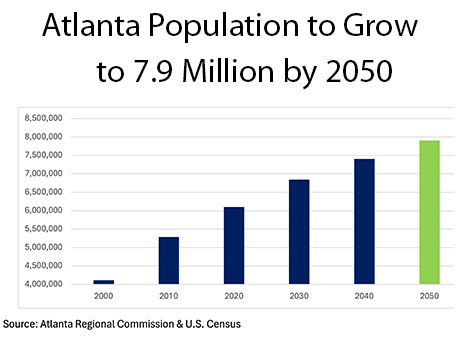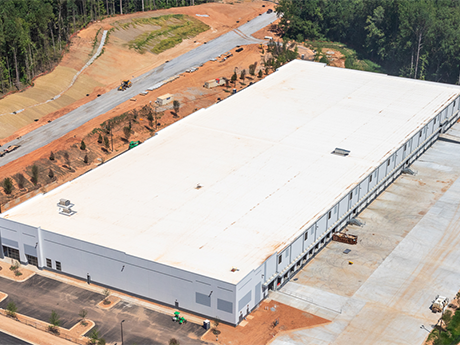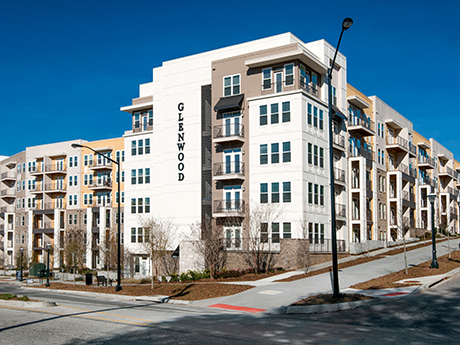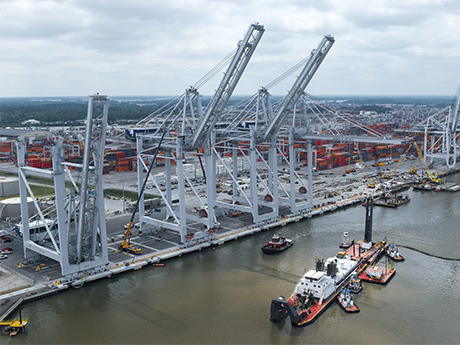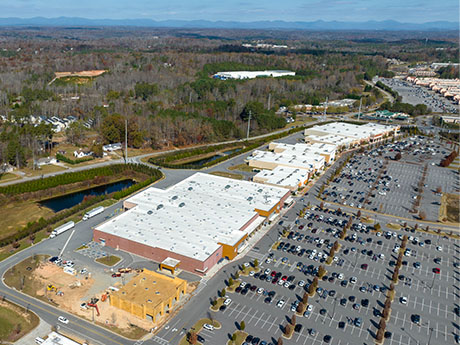By Charlie Adams and Walker Adams of NAI Brannen Goddard Industrial real estate in Atlanta is in limbo as of the second quarter of 2024. Certain submarkets in Atlanta have been overbuilt and tenant demand with historically active users (third-party logistics, wholesale, e-commerce, etc.) has decreased in comparison to what was seen over the last four years. As a result of the space grab during COVID-19, many logistics tenants are sitting on excess inventory within their buildings. Consumer demand has cooled, increased interest rates have dampened the economy as a whole and rents have risen 14.5 percent year-over-year, according to CBRE’s most recent report. The impact of these headwinds for traditional industrial (warehouse and distribution) real estate is positive. Developers haven’t had the fundamentals allowing overbuilding to a point of hyper-supply. Industrial construction starts have been few and far between over the past 12 months, and we believe this lack of new supply will keep Atlanta’s fundamentals healthy through this limbo we’re currently experiencing. With 4 million square feet of net absorption in first-quarter 2024 and 15.9 million square feet under construction, we should see 2025 vacancy in line with current vacancy, assuming absorption continues at a similar pace. Therefore, …
Market Reports
By Will Mathews and Mike Kidd of Colliers What is the reason behind Atlanta’s explosive growth over the last 20 to 30 years? Simply put, it’s been the exponential increase in population driven by an influx of new residents from the Northeast, Midwest and Mid-Atlantic. Atlanta is home to 17 Fortune 500 companies (the third-largest market in the nation), numerous high-paying jobs, a culturally diverse population and multiple prestigious universities, laying a strong foundation for incredible net migration. Multifamily investors are drawn to Atlanta, evidenced by the region’s high volume of multifamily transactions. According to MSCI Real Capital Analytics, Atlanta is currently ranked No. 4 in the country behind New York City, Dallas and Los Angeles in transactions. Despite challenges related to new supply and systematic traffic problems, the future of Atlanta’s multifamily market is very bright for a number of reasons. 7.9 Million by 2050 According to the Atlanta Regional Commission, the population of Atlanta will grow to 7.9 million, or an increase of 1.8 million people from 2020 to 2050. One of the direct beneficiaries of population growth is multifamily rent growth. Reflecting recent population trends, rent growth is forecasted to peak in the suburban counties east of …
Atlanta’s industrial sector and its historically strong performance have fortified the city as a strategic Southeast location and gateway market nationwide. Activity, which has decreased since peak demand during the COVID-19 pandemic, is now returning to normalized levels. The net new requirement pipeline remains robust primarily due to the influx of manufacturing, advanced manufacturing, life sciences, automotive, alternative energy and data center projects. How owners and tenants invest in industrial properties has also shifted. Owners are seeking properties with short weighted average lease terms and investments below replacement cost. Meanwhile, occupiers are making moves to crisis-proof their networks with onshoring and nearshoring of production that was previously conducted overseas, and they’re adjusting their overall supply chain and logistics strategies to diversify and avoid dependence on one region or vendor. Players in the market remain cautiously optimistic, which has subdued demand, but that is expected to be short-lived once macro-economic conditions stabilize. High inflation and rising interest rates over the past 12 to 18 months have significantly contributed to decreased demand in Atlanta. However, with continued population growth and Atlanta’s central location in the Southeast, the metro area’s compressed demand will be short-lived. With that said, Atlanta’s industrial market remains strong …
In recent years, Atlanta has become a top choice for corporate relocations, causing double-digit multifamily rental rate growth, an increase in pricing and a general benefit to the industry as a whole. In 2021, rental rates rose at an average of 11.7 percent and last year that number reached 16.8 percent. As a result, from 2021 through much of 2022 the metropolitan area experienced a record amount of investment activity, with $20.8 billion and $14.8 billion trading hands, respectively. During the first six months of 2023, however, transaction activity slowed and began returning to more typical levels, dropping approximately 82 percent year-over-year from those highs. Much of the decline in transaction activity experienced today can be accredited to the Federal Reserve’s sizable interest rate hikes over the past 18 months, resulting in a significant expansion in cap rates and a divide between buyer and seller pricing expectations. During the first half of 2023, approximately 54 transactions occurred, compared to 172 recorded for the same period last year for assets valued at $5 million or more. Much of this activity was driven by smaller deal sizes and private capital as institutional investors embrace a “wait and see” agenda in hopes of …
Savannah’s industrial real estate market is experiencing exceptional growth and now totals 113.7 million square feet, of which 98.2 million square feet (86 percent) is dedicated to bulk distribution (tracking facilities sized 100,000 square feet or larger). Year-to-date net absorption as of the end of the second quarter was 6.3 million square feet, which suggests another solid year ahead. Additionally, the vacancy rate remains low at 4.6 percent, a historically favorable level. The development community has been quick to respond to robust demand, delivering 19 buildings totaling nearly 10 million square feet in the second quarter, with the majority of it already leased. The market is primed for additional growth, with a significant amount of new construction underway. More than 16 million square feet is currently under construction, not including the Hyundai plant that will span 17 million square feet itself, along with related supplier facilities covering an additional 1.9 million square feet as of this writing. The $5.5 billion Hyundai plant will employ 8,100 people and be the company’s first dedicated electric vehicle (EV) mass-production plant. It is expected to begin full production in early 2025 and will produce over 300,000 vehicles per year. The effects of Hyundai on …
Against the backdrop of rising interest rates, recent financial stress and murkiness over the Federal Reserve’s ultimate direction and economic implications, dealmaking in the first half of 2023 has remained exceedingly challenged across all real estate sectors as wide bid-ask spreads persist. However, compared to other spaces, rental housing in the Southeast remains relatively healthy from a fundamentals perspective, despite supply-driven softening in the near term. This trend is evident in many major markets, including cities like Atlanta. Occupancy and rent growth remain healthy in Atlanta. The rental vacancy rate for Atlanta as of January 2023 reached 5.4 percent, a 0.9 percent decrease over the previous year, based on data from the U.S. Census Bureau. This falls below the national average of 5.8 percent for the fourth quarter of 2022. The median rental rate in January 2023 was also up 4.3 percent year-over-year, reaching $1,941. Population growth, employment opportunities, infrastructure investments, a business-friendly environment and other demand drivers continue to intensify Atlanta’s need for housing; and long term, the outlook for rental housing in the metro is very strong. More than 6 million people now live in the region, according to recent Census data. The Atlanta Regional Commission predicts more …
Five blocks doesn’t seem that far. It’s about a quarter of a mile, or 560 steps. But, it’s just a hair past convenient for today’s office workers. Now more than ever, tenants are seeking an office experience that is dynamic and energized with amenities. They want great options for coffee, lunch or happy hour that are steps away, not blocks. If it’s not right outside the office, it’s not close enough. In Atlanta, the Midtown submarket is still where the action is. In 2022, Midtown had 775,652 square feet of positive absorption, which was the highest in the metro according to Cushman & Wakefield. In keeping with the flight-to-quality trend, Atlanta leasing activity last quarter was dominated by Class A product, which accounted for 75.6 percent of all transactions. Most of this activity occurred in Midtown. With a Walk Score of 87, Midtown is Atlanta’s most walkable submarket. But even there, it’s the vertically integrated office developments that bring a new layer of urban density that are rising above the rest. Not only are they seeing more leasing demand, but they are also experiencing a constant hum of activity and energy due to immediate access to great retail and restaurants. …
Atlanta has historically been a favorite metro for real estate investors to consider when it comes to a market that checks all the boxes. The Peach State Capital and its surrounding suburbs always have been a beneficial and desirable region for residents to live and work. Topping the list as the most popular city for apartment renters in 2022, Atlanta offers more benefits to its residents than just an affordable city to live. Other benefits of living in and around the city include professional sports teams, a rich arts and entertainment scene and renowned restaurant and retail lineups, among others. Hartsfield-Jackson Atlanta International Airport also offers domestic and international flights to practically anywhere in the world, and it’s situated minutes from downtown. Home to 17 Fortune 500 company headquarters, including prominent names such as The Home Depot, United Parcel Service (UPS), Coca-Cola and Delta Airlines, Atlanta’s job growth is outpacing the rest of the country. Coming out of the pandemic, Atlanta recorded a job growth rate of nearly 23 percent since April 2020, which outperforms the comparative U.S. metric of 11.7 percent in the same time period. Atlanta has also historically held an unemployment rate below the national average. With …
The Atlanta industrial market needs very little validation when it comes to answering the question “Why Atlanta?” More than a dozen companies started or based in Atlanta have grown over the past decade to valuations above $1 billion. Metro Atlanta had the second highest rate of job growth in the nation among large metro areas (6.7 percent), according to the U.S. Bureau of Labor Statistics. So rather than ask “Why Atlanta,” the better question is “Where in Atlanta?” As the Southeast’s population continues to grow, the metro Atlanta area continues in equal parts to add density to its thriving urban core as well as expand its suburban reach. With limited geographic barriers to development, outlying towns are quickly becoming absorbed into the definition of the Atlanta area. This persistent growth is placing demand on industrial space at an all-time high, requiring a nuanced view of site selection within the Atlanta MSA. The four corners of the Atlanta market reach nearly 60 miles from the urban center in each direction along highways I-75 and I-85, with new speculative projects under construction as far out as Adairsville, Commerce, Locust Grove and La Grange. Its breadth now includes Bremen and Rutledge in either …
Affordable HousingBuild-to-RentGeorgiaMarket ReportsMultifamilySingle-Family RentalSoutheastSoutheast Market Reports
Why Investors Should Love Atlanta’s Multifamily Market
by John Nelson
Like most of the country, the metro Atlanta multifamily market has experienced a dramatic storyline over the past three years. While the continuing plot twists are difficult to predict, important cues suggest Atlanta’s multifamily market will reestablish a solid upward path quicker than many other cities in the country. Economic strength Atlanta’s economic fundamentals make it a favored market for investors, lenders, new residents, and business relocations. Today, metro Atlanta’s population stands at approximately 6 million, growing by 64,940 in 2022. Atlanta also added 126,400 new jobs in 2022. Georgia’s unemployment rate of 3.1 percent is below the national average of 3.6 percent. These figures are a key part of Atlanta’s desirability as an investment market and an indicator of the region’s ability to rebound quickly from cyclical economic disruptions. Record volume Atlanta is a top 10 U.S. market for multifamily inventory and investment. As the nation experienced an 11-year economic expansion after the Global Financial Crisis (GFC), Atlanta’s multifamily sales volume averaged between $7 billion and $9 billion annually. When the pandemic hit in March 2020, most industry participants expected a major transaction pullback. The reality proved different. Sales volume dropped initially but rebounded sharply for a full-year 2020 …



